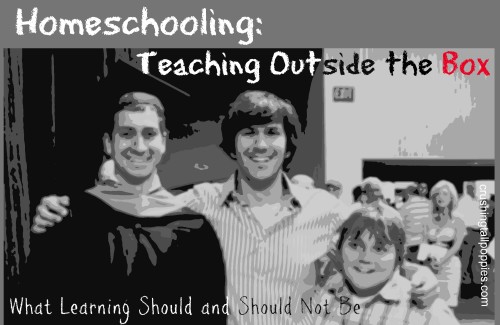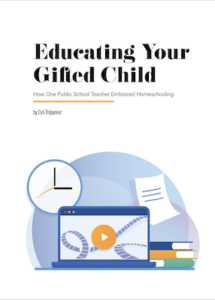Homeschooling: Teaching Outside the Box

~ What Learning Should and Should Not Be ~
Traditional classroom education is a well-known historical institution with an organizational structure and operational protocols that have changed little since its inception. The way this education system is run and the way it is structured focuses on educating classrooms of students in the most expedient and effective way. It is no wonder that the methods and customs of traditional classroom education is ingrained in us all.
And it is our long-held familiarity with traditional classroom education that influences the way many of us homeschool. It is hard to break free of the routine and organization of learning that we’ve grown accustomed to thanks to traditional schools. Homeschooling does not need to be anything at all like what we see in traditional schools. Homeschooling gives you the exclusive opportunity to TEACH OUTSIDE THE BOX!
With all the freedom and flexibility homeschooling provides, our choices can be overwhelming! In my 15-plus years of homeschooling, and through my own mistakes and experiences, I have developed some general homeschooling principles that I find myself repeating often when asked for advice on homeschooling. They are overarching guidelines that can be kept in mind when you homeschool, no matter which approach you feel best fits your family.
My homeschooling principles are based on the notion that we are programmed at birth to learn. By observing their environments and through self-exploration, babies, toddlers and children learn to sit up, to speak, mimic human behaviors, eat, crawl, and walk. Learning what is needed exists on a continuum starting at birth and probably would continue throughout one’s life without much intervention. Learning is natural and is inherently self-motivated. Sometimes too much intervention and regulation can interrupt the natural flow of self-motivated and self-directed learning. And I say “too much”, because I also believe that we can provide guidance and an enriched environment for our children to provide them a richer, more beneficial journey down their own learning continuum.
Homeschooling is the only educational option which can provide your child an education tailored to his needs, wants, desires and passions. If you are homeschooling, or thinking of homeschooling, you have the unmitigated opportunity to provide your child with a one-size-fits-one education – not a one-size-fits-all. Here are the homeschooling principles I’ve learned along the way that will nurture and maintain your child’s love of learning.
What learning should and should not be:
SHOULD BE: SELF-DIRECTED, CHILD-LED – More often than not, learning should be self-directed and child-led. Following your child’s lead in what your child wants to learn, and how learning occurs provides for optimal, stress-free, and more permanent learning.
SHOULD NOT BE: IMPOSED, REQUIRED – If your child does not see the real-world need to learn something, or he is not engaged in what he is learning, there probably won’t be much permanent learning occurring. He may remember what he learns enough to pass a test, but it may not “stick” much longer than needed to meet the stated outcome.
SHOULD BE: FUN, JOYFUL, DESIRED – When the majority of us think about school, we almost immediately have negative thoughts. How many kids smile and squeal with delight when they start hearing and seeing “Back to School” ads and sentiments? Learning should, and can be, fun and joyful. If a child desires to learn something, the pursuit of that learning will be fun, and it will lead to pure joy and self-satisfaction. When the fun and joy in learning is maintained, the end result is always positive, and permanent.
SHOULD NOT BE: BORING, PAINFUL, TEDIOUS – We’ve all done it. Whether in traditional school or homeschool, we’ve begged and bribed our kids to just do their school work and homework already. When learning is boring and tedious, your child will learn to hate learning, then it will be uphill from there. And then it becomes painful.
SHOULD BE: UNSCHEDULED, UNREGULATED, SPONTANEOUS – Of course, this is not always possible in homeschooling, but striving for the least restrictive learning environment for your child will keep learning fun and joyful. The second consideration here is when your homeschooling really needs some form of regulation or scheduling, strive to make the schedule fit your child’s natural inclinations. If your child really engages in her learning late afternoon into the evening, then try to work her homeschooling into this time period where she is most receptive and eager to learn. Lastly, spontaneity, or “teachable moments” are almost exclusive to homeschooling. They are a unique opportunity to learn something wonderful unexpectedly. Remember, learning can happen at ANY time, so try to go with it. The results are wondrous!
SHOULD NOT BE: SCHEDULED, TIMED, ROUTINE – Think about this situation: You and your child have been conducting a successful and mind-blowing Science experiment in the kitchen. Your child is super excited, asking a gazillion questions, and now asks to do Science experiments all afternoon because this is just so much fun. Learning is occurring like you’ve never seen, BUT your lesson plans didn’t call for more Science experiments and you really need to get your child to finish his Math from yesterday. You gently and nicely explain to your child that maybe you both can plan a day to do Science experiments next week. And the tears and tantrum begin immediately. Learning grinds to a sudden halt, and your child is no longer engaged or excited about learning. Forget the Math; it is not going to happen now either. This is an example of the pitfalls of being a slave to a inflexible schedule. Remember, spontaneity and flexibility when learning occurs is beneficial, and you have that flexibility with homeschooling.
SHOULD BE: TAILORED TO YOUR CHILD’S LEARNING NEEDS – What this means is simply this: Just because your child is 8 years old which, according to traditional school, would place him in 3rd grade, does not mean he has to learn 3rd grade Math, Science, English and Social Studies across the board. You can tailor his learning to meet his needs. Your child can, at 8 years old, use a 2nd grade Reading programs because he is a little behind in Reading, but simultaneously use a 5th grade Math curriculum because he excels in Math. Age/grade level placement is a man-made organizational structure, and is not at all a fail-proof system. This also means that your child can and should learn at his own pace: She can move through 3rd and 4th grade Math in one school year while taking two years to complete 5th grade English. As long as it meets her needs and there are no tears or resistance from her, then go ahead.
SHOULD NOT BE: MEETING THE NEEDS SET BY OTHERS – Just as I said above, typical textbooks follow the traditional schools age/grade level organization and yearly-progress pace, but you don’t need to.
SHOULD BE: CREATIVE, NEW – Homeschooling affords you the only educational option where learning can be creative and new. You can teach outside the box, the box of the traditional school system.
SHOULD NOT BE: BOXED, PREDICTABLE, ROUTINE – When you homeschool, your child’s learning does not have to come from the traditional boxed curriculum, paper-and-pencil tests, or workbooks. Your child does not have to follow the day by day, chapter by chapter pace and objectives of a traditional textbook curriculum.
Of course, none of us can implement and carry out all of these principals perfectly. I still struggle mightily with my need for organization, scheduling and predictability, most likely a remnant from my classroom teacher days! These are all general guidelines that can hopefully improve your homeschooling and quell some concerns you may have about how to best homeschool your child.
 Crushing Tall Poppies
Crushing Tall Poppies


